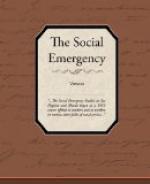Even in the case of wage-earning girls who adopt loose ways to satisfy extravagant desires, their tastes are established by women of the wealthy and middle classes. The leisure of these women is due to their wage-earning sisters, who in factories and mills make the cloth, prepare food-stuffs, and do all sorts of tasks that formerly kept women of the upper classes at home. Through the instinct of imitation, combined with the American feeling of democracy, the habits of the well-to-do determine the ambition of many a working-girl.
Other factors are industrial arrangements which segregate men in construction and lumber camps for a part of the year, and then, without providing for their further employment, turn them loose into cities where only saloons welcome them and cash their checks, and where disease-infected lodging-houses are their only places of abode. Furthermore, standing armies take thousands of able-bodied men out of normal industrial relationships, and keep them in camps that become the congregating places of prostitutes.
The most hopeful phase of the whole problem that it lies within the power of the State to transform the industrial environment through progressive legislation. The law cannot form character, but it can protect that which has been developed through voluntary effort. Vice is partly a by-product of industrial chaos which can be eradicated by industrial organization. When working-people can establish themselves more generally in homes of their own,—“every man under his vine, and under his fig tree,” as it were,—then they will be able to give more time to their children, and will perhaps cooeperate better in the program for sex instruction.
Economic improvements should include a minimum wage for women, and one for men based upon the needs of a family; the eight-hour day; insurance against sickness, old age, and accidents; relief of unemployment; one day’s rest in seven for all continuous industries; industrial education compulsory for all children; abolition of child labor; and amelioration of conditions under which women work.
When wage standards are raised, there arises the problem concerning those who cannot earn a living wage. “Who will pay poor, ignorant Mary Konovsky more than $6.90 a week?” is a question asked by a manufacturer during a minimum-wage discussion in New York State. The reply is, If Mary is really not worth more, she must be sent by the State to an industrial school until she can earn her living; and if she should be proved to be mentally deficient (as about 50 per cent of prostitutes are said to be), then she must be placed in an institution where she can be humanely and permanently cared for. The impossible alternatives are that she should be denied a living wage when she can earn it, or that she should be allowed to drift, in danger of becoming the prey of vicious men.




